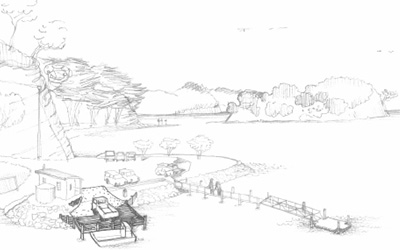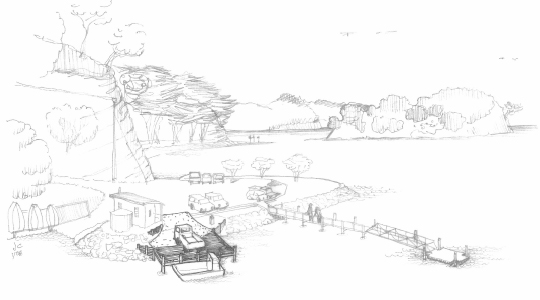Success after three decades bleatin’ into submission


Illustrating the Point: This rendering of the proposed vehicle wharf at Scotts Landing continues the work commenced by graphic artist John Cole, in 1987, aimed at bringing to life Mahurangi community-led initiatives. artist Jefferson Chapple
The locals’ vehicle-free concept blew the regional council’s plans for a road bridge across Te Muri out of the estuary.
It was 1986 and test drilling in the bed of the estuary had rudely reminded locals that the splendid isolation Te Muri enjoyed was about to be lost forever as the area was developed for road access, to take pressure off Wenderholm.
The farm manager had been kindly allowing locals walking access to the beach, prior to the Mahurangi Regional Park officially opening in 1988. This allowed an appreciation to develop for the refreshingly different experience that results from when access is by other than car. There was also the sublime pleasure of boating into the very tidal estuary—a hidden gem only be enjoyed, depending on the draft of the vessel, at the top of a largish tide. The road bridge proposed would have blocked that navigable waterway.
The campaign to save Te Muri from the spectre of a concrete road bridge and parking for 2000 cars mobilised the community, under the then-functioning Mahurangi West and Pukapuka Residents and Ratepayers Association. The park’s policymakers’ response was to stonewall, electing to defer the question of the bridge and instead address it as part of the park management plan process.
The organisation produced a document that included a concept for pocket car parks, courtesy of an engineer who holidayed at Jamieson Bay. It also included the route of a walkway and a boardwalk crossing well up the estuary and suitably camouflaged by the mangroves, all beautifully illustrated by the editor’s graphic designer cousin, John Cole, 1929–2000. In those days, a parks citizens advisory group was the first to evaluate submissions on a draft management plan, and its members were captivated by the organisation’s concept. Consequently, the principal author, who is now editor of the Mahurangi Magazine thought he’d learnt how to write a rip-snorter submission. He hadn’t, of course, it was simply that all the tumblers in the lock had lined up for the locals, on that occasion.
Three decades of submission writing by Mahurangi Action has failed to interest Rodney District Council in the development of a plan for the Mahurangi. There are, however, indications that it will now happen, as a consequence of the Mahurangi Action Plan, as part of a community-led, holistic and long-term approach to addressing the elevated sediment accumulation rate.
But this editorialising is not by way of lament, but of celebration. The cause of the editor’s joy: Mahurangi Action’s submission to the council’s draft development design guide has been embraced. The council’s design guide underscores a courageous new direction that seeks to optimise development outcomes, rather than simply throw the rulebook at every proposal. Mahurangi Action’s submission clarifies that the design guide addresses rural development, not just urban, and will see more emphasis on low impact design. It may also see the coastal section beefed up.
And the secret of the submission’s success: The person responsible for the design guide genuinely sought feedback; it was not just lip service to a statutory requirement to consult. Perhaps as significantly, the design guide is not part of a statutory process.
So, what are the chances of the Mahurangi Action submission influencing the Royal Commission on Auckland Governance?
An impeccable source suggests its chairman will take the responsibility to consult entirely genuinely…
Footnote While waiting to speak to a hearing of submissions on the regional park management plan, in 2001, the editor judged that the submitter ahead of him was doing it all wrong—bleating, it sounded to him, on and on, with not a kind thing to say about regional parks policy.
Then he noticed that the hearing committee was hanging on the man’s every word—the submitter, whose back was to the editor, was Judge Arnold R Turner. If anyone has ever paid their dues in respect to the regional parks it is Judge Arnold R Turner, including as chairman of the Regional Parks Committee of the Auckland Regional Authority from 1963 to 1968, when he oversaw the establishment of the first modern regional park: Wenderholm.
Judge Arnold Turner—now Arnold Turner cmg—was also the chairman of the citizens advisory group that so enthusiastically embraced the locals’ walking access concept, in spite of it being the antithesis of the park’s management’s plans for Te Muri.
